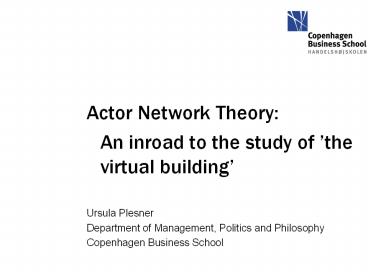Actor Network Theory: - PowerPoint PPT Presentation
Title:
Actor Network Theory:
Description:
Short introduction: the development of a framework for studying 'the virtual ... informants mix up organization, hardware, psychology etc. in one sentence, dont ... – PowerPoint PPT presentation
Number of Views:1419
Avg rating:3.0/5.0
Title: Actor Network Theory:
1
- Actor Network Theory
- An inroad to the study of the virtual building
- Ursula Plesner
- Department of Management, Politics and Philosophy
- Copenhagen Business School
2
Todays talk
- Short introduction the development of a
framework for studying the virtual building - The principles of the sociology of associations
- Methodological implications
- Group work
- Sum up ANT and the virtual
3
From levels, spheres or domains to long chains of
associations
The real/material
The virtual/immaterial
A particular site or social sphere
Action/interaction
4
Example An ANT study of the virtual building
- The virtual building as a promise, a contested
topic and a non-settled technology - An empty notion covering different technological
innovations and given different meanings by
different actors - An innovation in the making, which has not yet
been naturalized or black-boxed - The virtual building much more than a medium
representing other phenomena.
5
Building
Architectural training
Software
Percieved users
Technical information
Birds eye perspective
Users skills
Avatar
Designer
Navigation tools
Funding agencies
Users (citizens, politicians contractors, etc)
Aesthetics
Hardware
Surprises
Locked doors
6
Principles of the sociology of associations
- 1) A sociology sceptical of the social
- 2) An empiricist orientation
- 3) An agnostic, symmetrical approach
7
1) A sociology sceptical of the social
- There is no society, no social dynamics, no
social spheres - only associations made up by concrete ties
8
2) An empiricist orientation
- Refusal of abstract theory and the imposition of
categories and explanation on the empirical
material - The task of the researcher is not to impose
order, limit the range of acceptable entities or
add reflexivity to actors practice. But follow
the actors, their wild innovations, methods, and
accounts (Latour 2005 p.11)
9
3) An agnostic, symmetrical approach
- Impartiality between actors no à priori
priviledging of either humans or non-humans - "We know how to describe human relations, we know
how to describe mechanisms, we often try to
alternate between context and content to talk
about the influence of technology on society or
vice-versa, but we are not yet expert at weaving
together the two resources into an integrated
whole. This is unfortunate because whenever we
discover a stable social relation, it is the
introduction of some non-humans that accounts for
this relative durability (Latour 1991 111)
10
Methodological implications
- 1) Slowciology
- 2) Lack of generalizability empirical stories
(versus vampirical sociology) - 3) Mobile ethnography as approach?
11
1) Slowciology
- we have to chose to be literal, naive, and
myopic (Latour 2005, ca. 101) - 'slowciology'
- abandon the shorthand of social explanation,
- split hairs about what is or is not a group,
- register the queerest idiosyncracies of the
humblest actors, - make long lists of objects participating in
action, - focus on shifty matters of concern,
- follow the actors in all directions
12
2) Lack of generalizability (a)
- If your informants mix up organization, hardware,
psychology etc. in one sentence, dont break it
down into elements, but follow the link among
those elements (Latour 2005, interlude) - A discipline without a systematic production of
exemplars is an ineffective one - More discoveries have arisen form intense
observation than from statistics applied to large
groups - Thick and hard-to-summarize narratives are signs
of a rich pronlematic, - Summarizing and generalization is not an ideal
- The ideal is to allow the story to unfold and
expose complexity (Flyvbjerg 2006 219-38)
13
2) Lack of generalizability (b)
- Latours suggestions
- Good sociology has to be well written, so that
the social appears through it - Textual accounts must be accurate and truthful -
the absence of an absolute Text does not mean
that all texts are relative. - We must renew what an objective account is. It
does not use all-purpose meta-language, and no
'objective style language. Such forms disguise
the OBJECTS... An objective account brings
objects to the foreground. - We need to bring into the foreground the study
itself, the very making of reports.
14
3) Mobile ethnography
- The principle of following the actors
- From multi-sited to mobile looking at
connections rather than locations - "The object of ethnographic enquiry can usefully
be reshaped by concentrating on flow and
connectivity rather than location and boundary as
the organizing principle - (Christine Hine 2000 64)
15
Group task (Part 1, 20 minutes)
- Using one of your empirical fields as a case,
draw an extensive network of associations,
including all entities that might make a
difference for other entities. - Think of symbols, technologies, humans,
self-proclaimed groups, policies, documents,
architecture, emotions, ideals, significant
events, historical accounts, slogans, avatars,
user skills, etc. Be as inclusive as possible.
16
Group task (Part 2, 20 minutes)
- Discuss how the entities of the network are
associated. - Which entities might contribute to the
stabilization of the network? Which might
contribute to its destabilization? How do
elements make a difference in relation to the
others?
17
Sum up
- Which kinds of insights did the drawing and brief
analysis of the network produce? - What characterizes the kind of knowledge produced
by ANT on Virtual Worlds?
18
ANT and the virtual
- A material semiotics tries to capture relations
between material and discursive elements - The symbolic and the material not opposed, but
interwoven - Not reconciliation of dualities (subject/object,
material/symbolic, virtual/real) - The virtual not to be studied as a realm separate
from other realms

